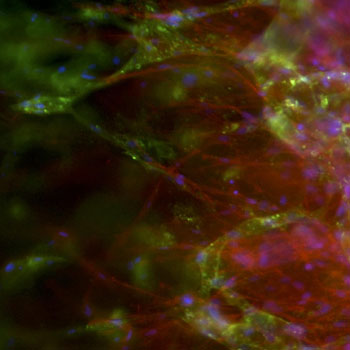3D Culture on Lysate Gel Scaffolds Prompt Microvascular Network Formation
By LabMedica International staff writers
Posted on 08 Jun 2016
Use of human platelet lysate gel as the support material for the three-dimensional culture of endothelial progenitor cells (EPCs) enables the formation of a complete microvascular network in vitro.Posted on 08 Jun 2016
Existing extracellular matrix (ECM) preparations used for in vitro growth of blood vessels require addition of high concentrations of recombinant growth factors and allow only limited formation of capillary-like structures.

Image: Lab-engineered human capillaries (in green) derived from stem cells are \"making contact\" with the sprouts protruding from a rat aorta (in red) (Photo courtesy of Tiago Fortunato, University of Bath).
Investigators at the University of Bath (United Kingdom) developed an improved blood vessel culture method based on a lysate gel prepared from human platelets (hPLG). This novel extracellular matrix preparation was able to support the proliferation of endothelial colony forming cells (ECFCs) in two-dimensional cultures and the formation of a complete microvascular network in vitro in three-dimensional cultures.
Additional advantages of this approach over existing extracellular matrices were the absence of any animal product in the hPLG composition and the possibility of obtaining hPLG from patients to generate homologous scaffolds for re-implantation.
In a paper published in the May 4, 2016, online edition of the journal Scientific Reports the investigators described the use of hPLG as an animal product-free and patient-specific tool to amplify, differentiate, and deliver ECFCs for regenerative medicine applications. They characterized the structure and composition of hPLG, and demonstrated the ability of this human-derived material to promote ECFC amplification and stimulate the formation of ECFC-driven microvascular networks in vitro. They also characterized the morphology and properties of the microvascular networks obtained in vitro.
Contributing author Dr. Paul De Bank, senior lecturer in pharmaceutics at the University of Bath, said, "By embedding EPCs in a gel derived from platelets, both of which can be isolated from the patient's blood, we have demonstrated the formation of a network of small vessels. What is more, the gel contains a number of different growth factors, which can induce existing blood vessels to infiltrate the gel and form connections with the new structures. Combining tissue-specific cells with this EPC-containing gel offers the potential for the formation of fully vascularized, functional tissues or organs, which integrate seamlessly with the patient. This discovery has the potential to accelerate the development of regenerative medicine applications."
Related Links:
University of Bath













